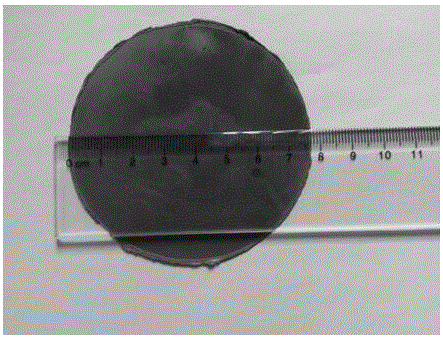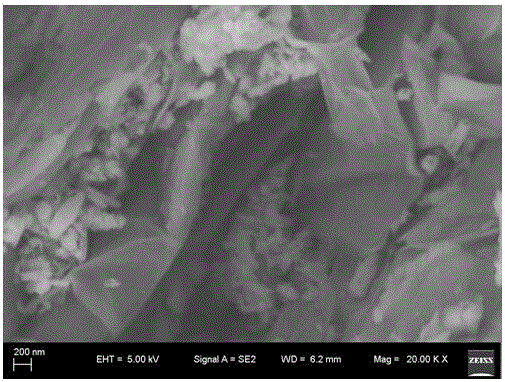Method for preparing composite polytetrafluoroethene conductive material
A technology of polytetrafluoroethylene and conductive materials, which is applied in the production field of composite polytetrafluoroethylene conductive materials to achieve excellent conductivity, promote uniform dispersion, and avoid aggregation
- Summary
- Abstract
- Description
- Claims
- Application Information
AI Technical Summary
Problems solved by technology
Method used
Image
Examples
Embodiment 1
[0023] Mix polytetrafluoroethylene with a particle size of 25 μm and modified graphene microflakes with a thickness of 15 to 20 nm in a mass ratio of 90:10, and prepare a uniform mixture of graphene microflakes and polytetrafluoroethylene by mechanical blending material.
[0024] The prepared powder was cold-pressed under a pressure of 35MPa and kept under pressure for 2 minutes. The obtained flake sample was removed from the mold, placed in a muffle furnace, raised to 370-380°C at a heating rate of 200°C / hour, kept for 2 hours, and then the sintered product was cooled to room temperature with the furnace to obtain a composite polyquaternary Vinyl fluoride conductive material.
[0025] The composite polytetrafluoroethylene conductive material is tested according to GB / T 1040-92, its elongation at break: 233.02%, tensile strength: 16.02MPa. GB / T 3960-1983 detection, its wear amount: 18mg, friction coefficient: 0.29. At room temperature, bulk conductivity: 0.1 S / cm.
Embodiment 2
[0027] Mix polytetrafluoroethylene with a particle size of 25 μm and modified graphene microflakes with a thickness of 15 to 20 nm at a mass ratio of 87:13, and prepare a uniform mixture of graphene microflakes and polytetrafluoroethylene by mechanical blending.
[0028] The prepared powder was cold-pressed under a pressure of 35MPa and kept under pressure for 2 minutes. The obtained flake sample was removed from the mold, placed in a muffle furnace, raised to 370-380°C at a heating rate of 200°C / hour, kept for 2 hours, and then the sintered product was cooled to room temperature with the furnace to obtain a composite polyquaternary Vinyl fluoride conductive material.
[0029] The composite polytetrafluoroethylene conductive material is tested according to GB / T 1040-92, its elongation at break: 119.41%, tensile strength: 15.74MPa. GB / T 3960-1983 detection, its wear amount: 9.8mg, friction coefficient: 0.20. At room temperature, volume conductivity: 0.54S / cm.
Embodiment 3
[0031] Mix polytetrafluoroethylene with a particle size of 25 μm and modified graphene microflakes with a thickness of 15-20 nm at a mass ratio of 85:15, and prepare a homogeneous mixture of polytetrafluoroethylene composite materials by mechanical blending.
[0032] The prepared powder was cold-pressed under a pressure of 40 MPa, and kept under pressure for 2 minutes. The obtained flake sample was removed from the mold, placed in a muffle furnace, raised to 370-380°C at a heating rate of 200°C / hour, kept for 2 hours, and then the sintered product was cooled to room temperature with the furnace to obtain a composite polyquaternary Vinyl fluoride conductive material.
[0033] The composite polytetrafluoroethylene conductive material is tested according to GB / T 1040-92, its elongation at break: 7.40%, tensile strength: 15.21MPa. GB / T 3960-1983 detection, its wear amount: 18.6mg, friction coefficient: 0.23. At room temperature, bulk conductivity: 0.57 S / cm.
PUM
| Property | Measurement | Unit |
|---|---|---|
| Particle size | aaaaa | aaaaa |
| Thickness | aaaaa | aaaaa |
| Tensile strength | aaaaa | aaaaa |
Abstract
Description
Claims
Application Information
 Login to View More
Login to View More - R&D
- Intellectual Property
- Life Sciences
- Materials
- Tech Scout
- Unparalleled Data Quality
- Higher Quality Content
- 60% Fewer Hallucinations
Browse by: Latest US Patents, China's latest patents, Technical Efficacy Thesaurus, Application Domain, Technology Topic, Popular Technical Reports.
© 2025 PatSnap. All rights reserved.Legal|Privacy policy|Modern Slavery Act Transparency Statement|Sitemap|About US| Contact US: help@patsnap.com



